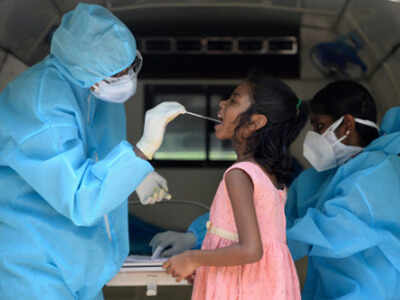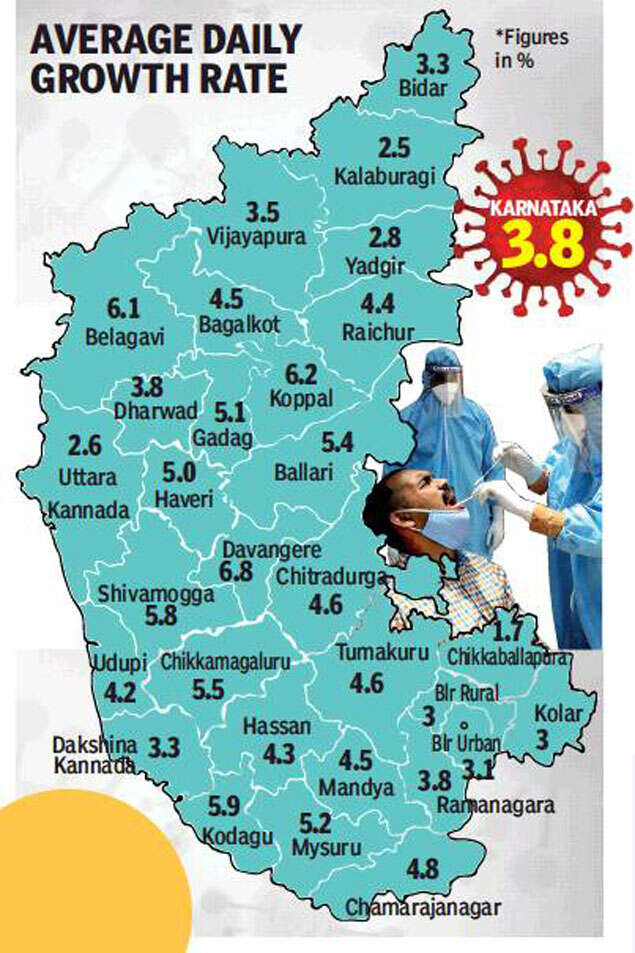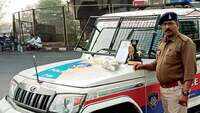
BENGALURU: With the rate of coronavirus infections climbing in Karnataka, the government’s focus has shifted to districts that have seen a case surge in the past 15 days.
Nearly 60 per cent of daily infections in the state now occur outside Bengaluru. If this trend continues, rural and semi-urban areas will account for about 80 per cent of the total caseload by month-end, according to members of the Covid-19 task force.

A month ago, a district took about a week to reach 100 infections. Now, up to 200 cases are recorded in a day. This is largely because more tests are being conducted with the help of new rapid antigen kits.
Districts other than Bengaluru are also seeing more deaths now. Twenty-nine districts collectively recorded about 1,000 deaths a month ago. The figure, as on August 17, stood at 2,579. Bengaluru Urban has seen over 1,483 Covid-19 deaths.
Among the districts, Mysuru has reported the highest number of fatalities (309 as on August 17), followed by Dakshina Kannada (275), Dharwad (239), Kalaburagi (170) and Ballari (169).
Ballari (14,507) leads in the caseload. Next on the table are: Mysuru (11,132), Kalaburagi (9,036), Dakshina Kannada (9,017), Udupi (8,242), Belagavi (7,965) and Dharwad (7,855). The districts reporting a high growth rate lately (over 5 per cent) are: Davangere, Koppal, Belagavi, Kodagu, Chikkamagaluru, Ballari, Mysuru, Gadag and Haveri.
The surging infection numbers have put dedicated Covid-19 hospitals under pressure. Since August 1, 100 to 200 coronavirus cases have been detected in the districts daily. Many doctors from various district hospitals were brought to Bengaluru to tackle the pandemic. Over the past few weeks, they have been rushed back to the districts, according to officials in the state health and family welfare department.
Bed capacity at major district hospitals and other medical facilities is being strengthened and necessary drugs like remdesivir are being restocked, a senior official said. “The lessons learned in Bengaluru are helping us manage the situation in the affected districts. We have been gradually increasing the number of Covid care centres in each district,” he added.
Some doctors at district hospitals said the state government should improve the quality of facilities, equipping beds with oxygen supply, to bring down the mortality rate, which is currently a concern. “The cases seem to be stagnating in Bengaluru, and there are more hospital discharges than admissions. This has given us some much-needed breathing space. But the trends in the districts are worrying as the peak is yet to come,” said another senior health official.
Medical facilities in many districts, especially in North Karnataka, are woefully inadequate. Improving this infrastructure is not the only challenge. The government must also recruit more doctors and nurses. Some districts have just one or two doctors for every 5,000 citizens. The figures for nurses are worse. The World Health Organization (WHO) recommends one doctor for every 1,000 people.
Some experts attribute the spike in Covid-19 cases in rural areas to three factors: lifting of lockdown, weak healthcare systems, and large movement of people from urban centres, especially Bengaluru.
What experts say
Dr Giridhara R Babu, epidemiologist and member of ICMR task force on Covid-19 surveillance and research, said: “The surge in all districts is a reality. The virus transmission pattern can temporarily be matched with areas having high population density; cities and large villages will see an inevitable increase in cases. We need to step up testing and ensure early isolation and timely referral. The only thing that matters is how we reduce mortality in every part that witnesses a surge.”
Dr CN Manjunath, nodal officer for testing in Karnataka, said: “We expect the cases to increase further because the government has ramped up testing. The cases have largely increased because of internal migration, district to district, after Unlock 1. Some border districts have also received huge number of people from Maharashtra, where the cases were high. The limited infrastructure in the districts is a huge worry. The government is trying to improve support services at rural hospitals.”
Nearly 60 per cent of daily infections in the state now occur outside Bengaluru. If this trend continues, rural and semi-urban areas will account for about 80 per cent of the total caseload by month-end, according to members of the Covid-19 task force.

A month ago, a district took about a week to reach 100 infections. Now, up to 200 cases are recorded in a day. This is largely because more tests are being conducted with the help of new rapid antigen kits.
Districts other than Bengaluru are also seeing more deaths now. Twenty-nine districts collectively recorded about 1,000 deaths a month ago. The figure, as on August 17, stood at 2,579. Bengaluru Urban has seen over 1,483 Covid-19 deaths.
Among the districts, Mysuru has reported the highest number of fatalities (309 as on August 17), followed by Dakshina Kannada (275), Dharwad (239), Kalaburagi (170) and Ballari (169).
Ballari (14,507) leads in the caseload. Next on the table are: Mysuru (11,132), Kalaburagi (9,036), Dakshina Kannada (9,017), Udupi (8,242), Belagavi (7,965) and Dharwad (7,855). The districts reporting a high growth rate lately (over 5 per cent) are: Davangere, Koppal, Belagavi, Kodagu, Chikkamagaluru, Ballari, Mysuru, Gadag and Haveri.
The surging infection numbers have put dedicated Covid-19 hospitals under pressure. Since August 1, 100 to 200 coronavirus cases have been detected in the districts daily. Many doctors from various district hospitals were brought to Bengaluru to tackle the pandemic. Over the past few weeks, they have been rushed back to the districts, according to officials in the state health and family welfare department.
Bed capacity at major district hospitals and other medical facilities is being strengthened and necessary drugs like remdesivir are being restocked, a senior official said. “The lessons learned in Bengaluru are helping us manage the situation in the affected districts. We have been gradually increasing the number of Covid care centres in each district,” he added.
Some doctors at district hospitals said the state government should improve the quality of facilities, equipping beds with oxygen supply, to bring down the mortality rate, which is currently a concern. “The cases seem to be stagnating in Bengaluru, and there are more hospital discharges than admissions. This has given us some much-needed breathing space. But the trends in the districts are worrying as the peak is yet to come,” said another senior health official.
Medical facilities in many districts, especially in North Karnataka, are woefully inadequate. Improving this infrastructure is not the only challenge. The government must also recruit more doctors and nurses. Some districts have just one or two doctors for every 5,000 citizens. The figures for nurses are worse. The World Health Organization (WHO) recommends one doctor for every 1,000 people.
Some experts attribute the spike in Covid-19 cases in rural areas to three factors: lifting of lockdown, weak healthcare systems, and large movement of people from urban centres, especially Bengaluru.
What experts say
Dr Giridhara R Babu, epidemiologist and member of ICMR task force on Covid-19 surveillance and research, said: “The surge in all districts is a reality. The virus transmission pattern can temporarily be matched with areas having high population density; cities and large villages will see an inevitable increase in cases. We need to step up testing and ensure early isolation and timely referral. The only thing that matters is how we reduce mortality in every part that witnesses a surge.”
Dr CN Manjunath, nodal officer for testing in Karnataka, said: “We expect the cases to increase further because the government has ramped up testing. The cases have largely increased because of internal migration, district to district, after Unlock 1. Some border districts have also received huge number of people from Maharashtra, where the cases were high. The limited infrastructure in the districts is a huge worry. The government is trying to improve support services at rural hospitals.”

Coronavirus outbreak
Trending Topics
LATEST VIDEOS
City
 Self-styled godman Nithyananda sets up a bank called Reserve Bank of Kailasa
Self-styled godman Nithyananda sets up a bank called Reserve Bank of Kailasa  Gujarat: Cop who never misses covering dead with shrouds spending money from his own pocket
Gujarat: Cop who never misses covering dead with shrouds spending money from his own pocket  J&K: Top LeT commander Sajjad alias Haider killed in Baramulla encounter
J&K: Top LeT commander Sajjad alias Haider killed in Baramulla encounter  Delhi riots case: Enforcement Directorate grills suspended AAP councillor Tahir Hussain
Delhi riots case: Enforcement Directorate grills suspended AAP councillor Tahir Hussain
More from TOI
Navbharat Times
Featured Today in Travel
Quick Links
Kerala Coronavirus Helpline NumberHaryana Coronavirus Helpline NumberUP Coronavirus Helpline NumberBareilly NewsBhopal NewsCoronavirus in DelhiCoronavirus in HyderabadCoronavirus in IndiaCoronavirus symptomsCoronavirusRajasthan Coronavirus Helpline NumberAditya ThackerayShiv SenaFire in MumbaiAP Coronavirus Helpline NumberArvind KejriwalJammu Kashmir Coronavirus Helpline NumberSrinagar encounter
Get the app



